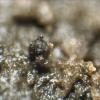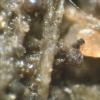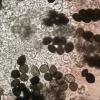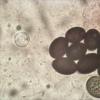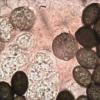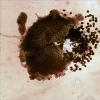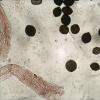
12-11-2025 09:25
 Viktorie Halasu
Viktorie Halasu
Hello, I need help with a pale terrestric Pseudom

11-11-2025 20:16
Bohan JiaHi, lastly I have found these tiny yellow decayin

09-11-2025 13:20
Hello.A tiny ascomycete, appearing as erupting gra

08-11-2025 00:29
 Francois Guay
Francois Guay
I found this species in Quebec, Canada, on herbace
 Found on horse dung.
Found on horse dung.Ascomata: Sphaerical; 366 um in diameter with a short neck 65 um wide & 34 um high.
Asci: 8-spored; 53-8-54.2 (-59.8)x21.6-24.8 (-28.4) um
Spores: biseriate; (13.4-)17.4-20.4x(13.2-)14.2-15.7x10.5-12.3 um; at first when immature sphaerical, becoming ellipsoidal and finally citriform with apiculate germ pores.
In contrast with the publication of Garcia the measurement of the ascomata is more than indicated and there was no report about the presence of a short neck (photo-8), not the best example but measurements are correct.
Photo-2 shows a spore release through the neck of the ascomata.
Reference:
Dania García, Alberto M. Stchigel, and Josep Guarro (2004) Two new species of Sphaerodes from Spanish soils; Studies in mycology 50: 65-66
X.W. Wang, F.Y. Bai, K. Bensch, M. Meijer, B.D. Sun, Y.F. Han, P.W. Crous, R.A. Samson, F.Y. Yang, and J. Houbraken (2019) Phylogenetic re-evaluation of Thielavia with the introduction of a new family Podosporaceae. Studies in mycology 93: fig. 9.
Yasmina Marin-Felix, Josep Guarro, José F. Cano-Lira, Dania García, Andrew N. Miller, Alberto M. Stchigel (2018) Melanospora (Sordariomycetes, Ascomycota) and its relatives Mycokeys 44: 114 & 109
Joop


Thanks for the reply I overlooked the fact of the ostiole and besides that the size of the ascomata is too big.
I have been looking for possibilities with ascomata having ostioles and a bigger size plus citriform spores and for that I ended up with Mi. marchicum.
According to Lindau (1886) and Saccardo (1899) the size of the ascomata and spores for Mi. marchicum are smaller, so no similarity.
It still may be a Microthecium species in my opinion but question is if it makes a diffecrence that the appearance of these species is mainly on soil and my finding was on dung.
Joop

